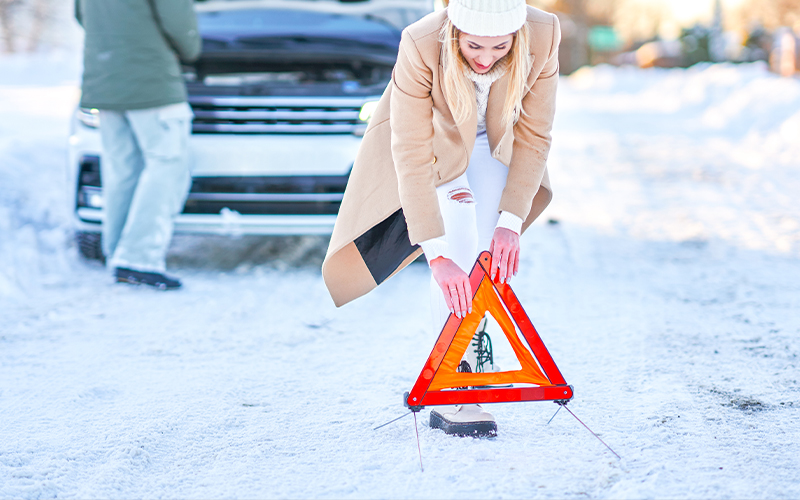How to Prepare an Emergency Travel Kit for Your Van in Winter Months

Table of Contents
1. What goes in a winter van kit?
2. Why is it important to have a winter van kit?
3. Winter tools for your winter van kit
4. Comfort items for your winter van kit
5. Safety items for your winter van kit
6. How to drive a van in winter
The harsh conditions of winter can take its toll on your van and put you more at risk of a breakdown.
That’s why it’s so important to be prepared before the weather changes with an emergency winter van kit.
We’ve rounded up the essentials that you should have in your winter van kit to be prepared for the upcoming winter months.
What goes in a winter van kit?
Winter weather is unpredictable, and you never know when you might get caught out. You might already have a lot of the basics in your van, but if not it’s important to stock up on a few essentials.
Your winter van kit should include a mixture of safety and comfort items, as well as tools.
Why is it important to have a winter van kit?
During the winter months, there’s a higher chance of adverse weather conditions. This includes fog, heavy rain, ice, and snow. Driving your van in these conditions can be dangerous and accidents can be more common on the roads.
If you regularly drive on the motorway, you could find yourself in standstill traffic for a long time in poor weather due to an accident. Even worse, your van could break down and leave you stranded.
That’s why it’s vital to have a winter van kit in case you find yourself in one of these tricky situations.
Making a winter van kit doesn’t have to be expensive and we’d recommend always carrying one in your van.
Winter tools for your winter van kit
- Shovel – while we wouldn’t recommend driving your van in heavy snow, the weather can change quickly. Make sure to always carry a shovel in the back of your van in case you need to dig your van out of deep snow.
- Warning triangles - if your van breaks down, you should display two warning triangles to alert other motorists. One should be displayed at the front of your van and the other at the rear. They should be placed at least 45 metres away from your van.
- Ice scraper and de-icer - it’s a legal requirement to keep your front and rear windscreen free of snow and ice. You might already carry both items. But if you don’t, make sure to stock up before the winter freeze hits. .
- Empty fuel can – while you’ll find petrol stations on most major motorways, you’re less likely to come across one off the beaten track. It’s not recommended to carry spare fuel as it can be dangerous. But an empty fuel can will come in handy in case you are within walking distance of a petrol station.
- Jump leads - if your van is slightly older, it could be more at risk of a flat or dead battery. Always carry a set of jump leads in your van to get moving again.

Comfort items for your winter van kit
- Warm clothes and blanket - packing warm items of clothing might not seem essential when the heating is cranked up inside your van. But if you break down, you could find yourself in a chilly situation without these items. If you have passengers in your van, make sure there is warm clothing and blankets for everyone.
- Sunglasses - the low-rising sun in winter can cause visibility and glare issues. Always have a pair of polarised sunglasses to hand all year round. Read our other tips for driving your van in low visibility.
Safety items for your winter van kit
- High visibility clothing - it's essential to have emergency high visibility clothing in case your van breaks down at night or on a dark unlit road. This will help other road users to see you clearly and prevent any accidents.
- Spare phone charger - carrying a spare portable charger is recommended all year round but even more so in winter. If your van battery cuts out and you become stranded, you’ll need to call for help.
- Torch - don't always rely on your smartphone for a torch in case of a worst-case scenario and it goes flat. Always carry a spare torch in case of emergencies.
- Food and drink - if your van breaks down and you become stranded, that is bad enough. But imagine being stranded with no food or water. Always keep bottled water and non-perishable snacks in your van in case of an emergency. For something warming, a flask of soup is also great to have on hand too.
- First aid kit - carrying a first aid kit in your van is good practice all year round in case of any minor injuries on the road. Specialist first aid kits are available for van drivers. These often include:
- Bandages and burn dressings
- A foil blanket
- Resuscitation face shield
- Sterile wipes
How to drive a van in winter
Winter weather can bring harsh driving conditions and it’s important to be prepared before the first freeze strikes. Visibility can be reduced, and roads become slippery due to snow and ice. But if you and your van are prepared, there’s no need to stress.
- Give your van a winter check – ensure that key items including tyres, windscreen wipers, and brakes are all in working order.
- Plan your journey ahead - winter weather is unpredictable and can change quite quickly. Always check the weather before setting off and if your journey is not essential – stay at home until the weather improves.
- Take your time- if your journey is essential, take your time and reduce your speed. Increase the distance between your van and vehicles in front to allow for more reaction time.
For more tips on how to drive your van in winter, read the van driver’s guide to winter driving.
Is your van ready for winter?
If not, it could be time for an upgrade. Explore our wide range of van leasing deals and new vans in stock with quick delivery.
As well as van leasing, we also offer a range of van finance offers including contract hire, hire purchase, and van fleet leasing. Contact us today to discover which van finance offer is best for you and your business.
Did you know you can also sell your old van with us? Get a free, no-obligation valuation with Sell My Van. The price is guaranteed for seven days and there are no admin fees.
Related blog articles
How to Properly Defrost Your Van’s Windscreen
Tips for Driving Your Van During Low Visibility
Tips for Driving Different Van Types This Winter
Van Snow Chains vs. Winter Van Tyres: Which is Better?
















